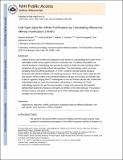Cell type–specific mRNA purification by translating ribosome affinity purification (TRAP)
Author(s)
Heiman, Myriam; Kulicke, Ruth; Greengard, Paul; Heintz, Nathaniel; Fenster, Robert
DownloadHeiman_Cell type-specific.pdf (1.564Mb)
OPEN_ACCESS_POLICY
Open Access Policy
Creative Commons Attribution-Noncommercial-Share Alike
Terms of use
Metadata
Show full item recordAbstract
Cellular diversity and architectural complexity create barriers to understanding the function of the mammalian CNS at a molecular level. To address this problem, we have recently developed a methodology that provides the ability to profile the entire translated mRNA complement of any genetically defined cell population. This methodology, which we termed translating ribosome affinity purification, or TRAP, combines cell type–specific transgene expression with affinity purification of translating ribosomes. TRAP can be used to study the cell type–specific mRNA profiles of any genetically defined cell type, and it has been used in organisms ranging from Drosophila melanogaster to mice and human cultured cells. Unlike other methodologies that rely on microdissection, cell panning or cell sorting, the TRAP methodology bypasses the need for tissue fixation or single-cell suspensions (and the potential artifacts that these treatments introduce) and reports on mRNAs in the entire cell body. This protocol provides a step-by-step guide to implement the TRAP methodology, which takes 2 d to complete once all materials are in hand.
Date issued
2014-05Department
Massachusetts Institute of Technology. Department of Brain and Cognitive Sciences; Picower Institute for Learning and MemoryJournal
Nature Protocols
Publisher
Nature Publishing Group
Citation
Heiman, Myriam, Ruth Kulicke, Robert J Fenster, Paul Greengard, and Nathaniel Heintz. “Cell Type–specific mRNA Purification by Translating Ribosome Affinity Purification (TRAP).” Nature Protocols 9, no. 6 (May 8, 2014): 1282–1291.
Version: Author's final manuscript
ISSN
1754-2189
1750-2799